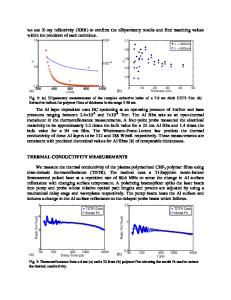2D interspace confined growth of ultrathin MoS 2 -intercalated graphite hetero-layers for high-rate Li/K storage
- PDF / 3,060,005 Bytes
- 8 Pages / 612 x 808 pts Page_size
- 121 Downloads / 284 Views
rtment of Applied Chemistry, University of Science and Technology of China, Hefei 230026, China Hefei National Laboratory for Physical Sciences at the Microscale, University of Science and Technology of China, Hefei 230026, China 3 College of Chemical Engineering, Ningbo Polytechnic, Ningbo 315800, China 4 Ningbo Veken Battery Co.Ltd, Ningbo 315800, China § Yang Li and Song Jiang contributed equally to this work. 2
© Tsinghua University Press and Springer-Verlag GmbH Germany, part of Springer Nature 2020 Received: 3 March 2020 / Revised: 20 September 2020 / Accepted: 29 September 2020
ABSTRACT Herein, a two-dimensional (2D) interspace-confined synthetic strategy is developed for producing MoS2-intercalated graphite (G-MoS2) hetero-layers composite through sulfuring the pre-synthesized stage-1 MoCl5-graphite intercalation compound (MoCl5-GIC). The in situ grown MoS2 nanosheets (3–7 layers) are evenly encapsulated in graphite layers with intimate interface thus forming layer-by-layer MoS2-intercalated graphite composite. In this structure, the unique merits of MoS2 and graphite components are integrated, such as high capacity contribution of MoS2 and the flexibility of graphite layers. Besides, the tight interfacial interaction between hetero-layers optimizes the potential of conductive graphite layers as matrix for MoS2. As a result, the G-MoS2 exhibits a high reversible Li+ storage of 344 mAh·g−1 even at 10 A·g−1 and a capacity of 539.9 mAh·g−1 after 1,500 cycles at 5 A·g−1. As for potassium ion battery, G-MoS2 delivers a reversible capacity of 377.0 mAh·g−1 at 0.1 A·g−1 and 141.2 mAh·g−1 even at 2 A·g−1. Detailed experiments and density functional theory calculation demonstrate the existence of hetero-layers enhances the diffusion rates of Li+ and K+. This graphite interspace-confined synthetic methodology would provide new ideas for preparing function-integrated materials in energy storage and conversion, catalysis or other fields.
KEYWORDS interspace-confined, MoS2-intercalated graphite, hetero-layers, Li+ storage, potassium ion battery
1
Introduction
Currently, lithium-ion batteries (LIBs) are widely used in smart devices, electrical vehicles and energy storage owing to the high energy density and prominent cycling performance [1]. However, the development of LIBs in the future market will be affected by the scarcity of lithium resources (0.065%) in the earth’s crust [2]. Consequently, alternative rechargeable batteries based on other abundant elements in the earth’s crust (such as Na, K, Mg and Zn) are developing rapidly in recent years [3–6]. Potassium ion batteries (PIBs), sharing the analogous “rocking chair” mechanism, have been attracted increasing attention due to the rich reserves of K (2.85%) and the lower redox potential of K/K+ (−2.93 V) closed to Li+/Li (−3.04 V) [7]. The main challenge facing both LIBs and PIBs is the unsatisfying energy density, which is dominated by the reversible capacity of electrode materials. The well-developed graphite anode can react with Li and K to form LiC6 and KC8 w
Data Loading...











